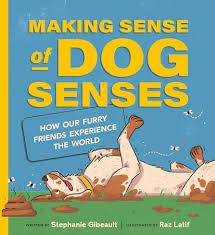Making Sense of Dog Senses: How Our Furry Friends Experience the World
- context: Array
- icon:
- icon_position: before
- theme_hook_original: google_books_biblio

Making Sense of Dog Senses: How Our Furry Friends Experience the World
Whiskers are longer, stiffer and thicker than the hair that makes up a dog’s fur. And at the root of each whisker, there are plenty of cells called touch receptors that send messages to the brain when the whisker moves. In fact, each whisker signals its own area of the brain, just like you know which fingertip is touching something, the dog knows which whisker is bent.
Whiskers are so sensitive that they don’t even have to touch an object for the dog to know something is there. Air currents around an object can move a whisker enough to alert the dog. Imagine how useful that is, especially in the dark. Plus, since dogs don’t see details very well, whiskers help them sense the size and shape of objects near their mouths and eyes as well as help then know if they have enough room to fit through a small space. That’s pretty smart for eyebrows and a beard!
With a background in animal behaviour science and experience as a professional dog trainer, author Stephanie Gibeault brings a wealth of information to this engaging and educational book about a popular subject. Gibeault not only presents the facts (some of them little-known) about dogs’ senses, but she also dispels some myths, including that dogs see only in black and white (in fact, they see a limited range of colours, from yellow to blue to gray). The book is divided into six main chapters, one for each of the senses, plus a concluding chapter which highlights a dog’s “sixth sense”, known as magnetoreception, which helps dogs to find specific locations without relying solely on sight and smell. There is also a “Senses Showdown” which compares human senses to those of dogs.
Each chapter explains in detail a specific canine sense and provides some fascinating facts. For example, in the chapter on smell, readers will earn why a bloodhound is such a good tracker. In addition to his wet nose and nostril slits which capture scents, the wrinkles, droopy ears, dewlaps and jowls also trap scent particles while the bloodhound’s tongue carries odor into the mouth and closer to the nose. A dog can smell just a few particles of a scent in one trillion particles of air which Gibeault likens to finding a single mint jelly bean in a huge arena filled to the rafters with assorted jelly beans. The remaining chapters are similar in terms of interesting facts which demonstrate how a dog’s super senses relate to canine survival and evolution.
Sidebars provide additional information while a related experiment for each of the senses reinforces concepts. These experiments require little or no equipment and are easy to follow.
The colourful, vibrant illustrations, some of them infused with humour, consist of cartoon-like drawings as well as some diagrams. A table of contents, a glossary and an index are included along with “Fetching Further Facts” which is a list of resources for further study.
Dog lovers and pet owners will likely understand their dogs a lot better after reading Making Sense of Dog Senses: How Our Furry Friends Experience the World, a highly appealing book!
Gail Hamilton, a dog lover and former teacher-librarian, lives in Winnipeg, Manitoba.
